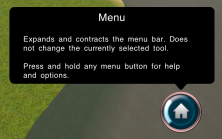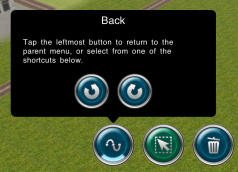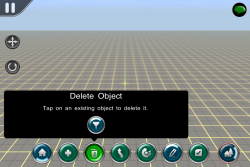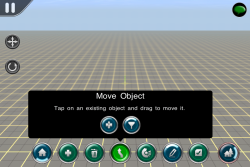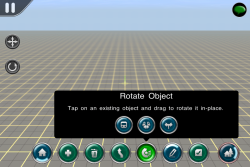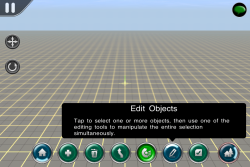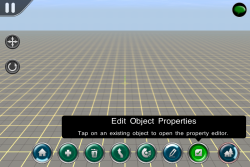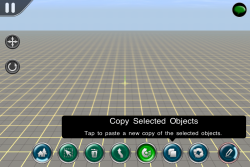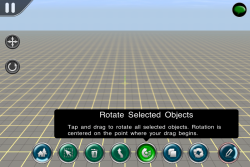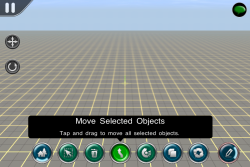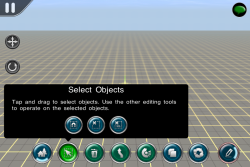Help:Mobile Surveyor
Tonyhilliam (Talk | contribs) (→Objects Menu) |
Tonyhilliam (Talk | contribs) (→Objects Menu) |
||
| Line 102: | Line 102: | ||
[[File:Add object.PNG|250px]] | [[File:Add object.PNG|250px]] | ||
Adding an object to the world: | Adding an object to the world: | ||
| − | *Tap the Add Object | + | *Tap the Add Object button to open the selection window |
| − | *Select an item from the scrollable list (use Filter if required) | + | *Select an item from the scrollable list (use Filter first, if required) |
| − | *Tap the Add Object | + | *Tap the Add Object button to close the window |
*Tap in the 3D world to place the item | *Tap in the 3D world to place the item | ||
*Tap again to place another item in the world | *Tap again to place another item in the world | ||
| + | |||
| + | ===Using the Object Picker=== | ||
| + | *Tap the Add Object button to open the selection window | ||
| + | *Tap the Picker button (use Filter first, if required) | ||
| + | *Tap the Add Object button to close the window | ||
| + | *Tap an item in the 3D world (the selection window appears to confirm the item selected) | ||
| + | *Tap the Add Object button to close the window | ||
| + | *Tap in the 3D world to place the selected item | ||
| + | |||
| + | ===Using the Object Filter=== | ||
| + | The filter allows a user to reduce or increase the number of items showing in the selection window. | ||
| + | There are two types of filter: | ||
| + | * Content Type: Tap the filter buttons to toggle various content types on or off. This is very useful to show just the type of object that you are currently working with. | ||
| + | * Item Name: Type in the name field to filter any items that include the characters typed. e.g. type 'mobile' to show items with the word 'mobile' in the name | ||
[[File:Delete object.PNG|250px]] | [[File:Delete object.PNG|250px]] | ||
Revision as of 13:43, 21 July 2014
The Surveyor Module provides a set of tools that enable anyone to create their own Route and Sessions. This can be a simple looped track or a prototypical masterpiece using real-world data and accurately modeled and placed track and scenery.
Contents |
Getting Started
Surveyor is entered through the "Routes" menu tile at the Trainz main menu. There are four options for entering Surveyor which each have a slightly different effect:
- "Create Route" - Available at the top level of the "Routes" menu, this button creates a new blank route and opens Surveyor so that you may begin editing the route. By default, any edits occur in the route layer (see layers below.)
- "Edit Route" - Available at the top level of the "Routes" menu once you have selected any route from the list. This opens the selected route for editing in Surveyor. By default, any edits occur in the route layer (see layers below.)
- "Create Session" - Available from the session submenu of the "Routes" menu, after selecting "View sessions" from the top-level menu. This creates a new gameplay session for the selected route and opens Surveyor so that you may begin editing the session. By default, any edits occur in your new session layer (see layers below.) The route layer(s) are locked initially and must be unlocked before you can edit the route.
- "Edit Session" - Available from the session submenu of the "Routes" menu, after selecting "View sessions" from the top-level menu and then selecting a session from the list. This opens the existing gameplay session for editing in Surveyor. By default, any edits occur in the session layer (see layers below.) The route layer(s) are locked initially and must be unlocked before you can edit the route.
Screen Layout
Once you are in Surveyor, you will be presented with a screen layout similar to the following image:
In the top left of the screen is the main menu button. On the left side of the screen are the camera control buttons. On the top right of the screen are the utility buttons, and at the bottom right of the screen is the Surveyor Menu from which you can access all Surveyor functionality. Each part of the screen is described in detail below.
Main Menu
![]() At the top left of the Surveyor screen is a "pause" icon button, which displays the Main Menu. The following options are available from this menu:
At the top left of the Surveyor screen is a "pause" icon button, which displays the Main Menu. The following options are available from this menu:
- "Back to Game" - Dismisses the menu and returns you to Surveyor.
- "Options" - Displays the game options dialog.
- "Account Details" - Allows editing of the Planet Auran account details.
- "Achievements" - Shows the list of achievements, including the current progress toward further achievements.
- "Save" - Saves the current Surveyor route and/or session. If you are editing a new route or session, this will prompt you for an appropriate save name.
- "Save As" - Saves the current Surveyor route and/or session, prompting for a new save name.
- "Find Object" - Allows you to find a named object on the route.
- "Exit Surveyor" - Exits Surveyor and returns to the Main Menu. Surveyor will offer to save any edits made to the current route and/or session.
Camera Controls
Camera Mode Buttons
Two camera control buttons are available on left side of the screen. These buttons are, from top to bottom:
- "Move Camera" - Tap this button to enter "move" mode. Drag anywhere on the 3D world to move the camera. If the button is held instead of tapped, you can make a quick multi-touch adjustment to camera position without changing modes.
- "Rotate Camera" - Tap this button to enter "rotate" mode. Drag anywhere on the 3D world to rotate the camera without changing the center of focus. If the button is held instead of tapped, you can make a quick multi-touch adjustment to camera position without changing modes.
Whenever a camera mode button is activated, the current Surveyor editing tool is temporarily deactivated. If you tap the active camera mode button a second time, it will deactivate returning you to the previously selected Surveyor editing tool.
If no Surveyor editing tool is currently active, any touch gesture will be treated as per "Move Camera" mode.
Multitouch Gestures
In both camera adjustment modes, pinching will zoom the camera. At extreme distance, the camera will automatically adjust to face directly downward, and the view will transition between the local 3D view and a "minimap" overview.
In both camera adjustment modes, sliding two fingers vertically will cause the camera to tilt up or down, changing the angle of the horizon.
In the "move" camera mode, rotating two fingers in place on the screen will cause the camera to rotate around its point of focus.
Surveyor Menu
The Surveyor menu is accessed through an omnipresent button at the bottom right of the screen. This button changes icon to show the current menu mode, but always has the same functionality: tap the button to reveal the menu buttons, and tap it again to hide them. Hiding the menu buttons does not deactivate the currently selected tools or options, it simply clears up some screen space so that you can work unrestricted.
Tapping and holding any menu button causes a popover to open which both display help on the button in question, and also (where applicable) presents options that can be adjusted which relate to the button.
Each other button on the top-level menu represents one of the major categories of Surveyor editing tools. Tapping any of these buttons opens a separate menu of related tools. The Surveyor menu button icon will change to reflect your selected category. When in any submenu, the leftmost button is always a "back" button. The back button also offers "undo" and "redo" options in case you need to access these functions quickly.
Whenever you tap or hold on a menu button, the name of that button will appear briefly. This can act as a quick confirmation that you've got the right button, or can be used to understand what action an unknown button might perform. If you decide that you've tapped the wrong button, you can drag your finger off the button before lifting to cancel the tap.
Within each menu category are a number of different tools and commands relating to that category. These are reviewed in detail below, however there are some common visual effects which help guide you through the buttons. Understanding these up-front will help with learning your way around the menus.
Firstly, each menu button may have a highlight on the top, bottom, left, or right. These are used as follows:
- Top - A button with a top highlight has a sub-menu. Tapping the button will leave the current menu and reveal the sub-menu.
- Bottom - The back button has a bottom highlight. Tapping the back button will leave the current sub-menu and return to the parent menu.
- Left / Right - The Surveyor menu button will show a left or right highlight depending on its current mode. This indicates that the menu will expand or contract (respectively) when this button is tapped.
Secondly, each menu button has a colored background:
- Blue - The blue buttons are commands. Tapping the button will have an immediate effect, whether this is to open a sub-menu or to perform a set action.
- Green - The green buttons are tools. Tapping the button will activate the tool, but will not have any immediate effect. You can then tap in the 3D world to utilise the button. In some cases you may need to customise the tool options by pressing and holding on the tool's button. The currently active tool has a brighter-colored button background.
System Menu
TBD
Ground Menu
TBD
Splines Menu
TBD
Objects Menu
w.i.p.
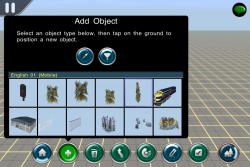
- Tap the Add Object button to open the selection window
- Select an item from the scrollable list (use Filter first, if required)
- Tap the Add Object button to close the window
- Tap in the 3D world to place the item
- Tap again to place another item in the world
Using the Object Picker
- Tap the Add Object button to open the selection window
- Tap the Picker button (use Filter first, if required)
- Tap the Add Object button to close the window
- Tap an item in the 3D world (the selection window appears to confirm the item selected)
- Tap the Add Object button to close the window
- Tap in the 3D world to place the selected item
Using the Object Filter
The filter allows a user to reduce or increase the number of items showing in the selection window. There are two types of filter:
- Content Type: Tap the filter buttons to toggle various content types on or off. This is very useful to show just the type of object that you are currently working with.
- Item Name: Type in the name field to filter any items that include the characters typed. e.g. type 'mobile' to show items with the word 'mobile' in the name
Environment Menu
TBD
Layers
Objects in Surveyor are divided between the Route and Session. Typically, the Route will represent an entire map including the ground, water, scenery, industries, track, signals and junctions. These features are then common to every session which is built for that route. The sessions will add specific gameplay-relevant objects and mechanics including Trains and Session Rules, although it is also possible to add extra track-work, signals, track marks, and so forth. It is actually possible to place most objects in either the route or session, with the exception of the ground height, texture, and water (which is route only) and the session rules (which are session only.)
Within both the route and the session, objects can be further subdivided between individual layers. Placing an object into a particular layer does not typically have any gameplay impact, however it can be used to simplify editing. For example, by placing all trees and similar scenery into a separate layer, you can hide them all temporarily when working on the track or other aspects of the route, or you can lock the layer to prevent accidental edits.
To access the layer controls, expand the surveyor menu buttons, tap on the "Environment" button from the top-level menu, then tap on the "Layers" button. A list of all available layers is displayed, with route layers on the left and session layers on the right. "Add" buttons are available to insert new layers into either the route or session. The currently selected layer is shown in green. All editing operations which affect a specific layer (such as adding new objects) will modify the selected layer. To change to a different layer, simply tap on the appropriate button so that it turns green. Multiple layers may be visible and unlocked simultaneously, but only one layer is selected.
Pressing and holding on any layer button will reveal the options popover for that layer. This allows you to show or hide the layer, lock or unlock the layer, rename the layer, delete the layer, or merge the layer into another.
Protected Content
Some content is protected from editing and/or cloning. For example, purchased content is not typically available for cloning or modification. Access to protected content is permitted as follows:
- Payware Routes - Payware routes cannot be edited. It is possible to create a new session for an existing payware route, however.
- Payware Sessions - Payware sessions cannot be edited.
- Download Station Content - Routes and Sessions downloaded from the Trainz Download Station must be cloned before editing. The main menu will prompt you about this if it is required. You do not need to take additional steps except where prompted.

